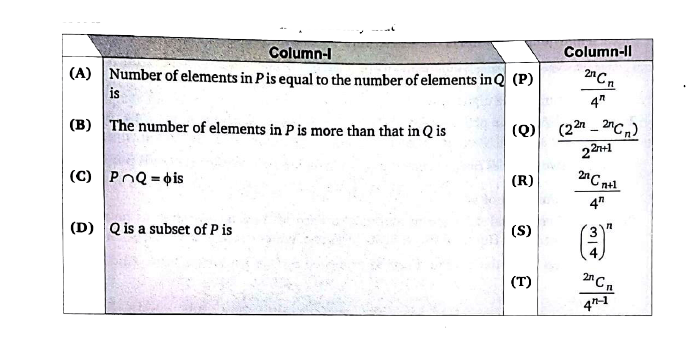In an experiment a coin is tossed 10 times.
Q. Probability that no two heads are consecutive is :
143210
926
27−1210
26−126
The correct Answer is:B
Step by step video solution for In an experiment a coin is tossed 10 times. Q. Probability that no two heads are consecutive is : by Maths experts to help you in doubts & scoring excellent marks in Class 12 exams.
Updated on:21/07/2023Topper's Solved these Questions
- PROBABILITY Book:VIKAS GUPTA (BLACK BOOK) ENGLISHChapter:PROBABILITY Exercise:Exercise-4 : Matching Type Problems
Explore 1 Video
- PROBABILITY Book:VIKAS GUPTA (BLACK BOOK) ENGLISHChapter:PROBABILITY Exercise:Exercise -5 : Subjective Type problems
Explore 11 Videos
- PROBABILITY Book:VIKAS GUPTA (BLACK BOOK) ENGLISHChapter:PROBABILITY Exercise:Exercise-2 : One or More than One Answer is/are Correct
Explore 4 Videos
- PERMUTATION AND COMBINATIONS Book:VIKAS GUPTA (BLACK BOOK) ENGLISHChapter:PERMUTATION AND COMBINATIONS Exercise:Exercise-5 : Subjective Type Problems
Explore 13 Videos
- QUADRATIC EQUATIONS Book:VIKAS GUPTA (BLACK BOOK) ENGLISHChapter:QUADRATIC EQUATIONS Exercise:EXERCISE (SUBJECTIVE TYPE PROBLEMS)
Explore 45 Videos
Similar Questions
A is a set containing n elements, A subset P (may be void also) is selected at random from set A and the set A is then reconstructed by replacing the elements of P. A subset Q (may be void also) of A is again chosen at random. The probability that

View SolutionMr. A writes an article. The article originally is error free. Each day Mr. B introduces one new error into the article. At the end of the day, Mr. A checks the article and has 23 chance of catching each individual error still in the article. After 3 days, the probability that the article is error free can be expressed as pq where p and q are relatively prime positive integers. Let λ=q−p, then find the sum of the digits of λ.
View SolutionA consignment of 15 record players contain 4 defectives. The record players are selected at random, one by one and examined. The one examined is not put back. Then : Find the Probability that 9th one examined is the last defective is 8195.
View SolutionThe number of ways in which eight digit number can be formed using the digits from 1 to 9 without repetition if first four places of the numbers are in increasing order and last four places are in decreasing order is N, then find the value of N70.
View SolutionLet f(x)=ax2+bx+c where a,b,c are integers. If sinπ7.sin3π7+sin5x7+sin5π7sin5π7+sinπ7=f(cosπ7), then find the value of f(2):
View SolutionA coin is tossed three times, if head occurs on first two tosses, find the probability of getting head on third toss.
View SolutionIf an unbiased coin is tossed 10 xx then the probability that no two consecutive heads occurs is
View SolutionA coin is tossed 10 xx.Find Probability 3 consecutive heads do not appear
View SolutionIn an experiment a coin is tossed 10 times.
Q. Probability that no two heads are consecutive is :
View SolutionIn an experiment a coin is tossed 10 times.
Q. The probability of the event that "exactly four heads occur and occur alternately" is :
View SolutionA coin is tossed three times, if head occurs on first two tosses, find the probability of getting head on third toss.
View SolutionA coin is tossed 10 times. What is the probability of getting exactly 7 consecutive tails, no two other tails being consecutive?
View SolutionIf 10 coins are tossed, find the probability that no two or more consecutive heads occur.
View SolutionIf 5 coins are tossed find the probability that no two or more consecutive heads occur.
View SolutionIf a fair coin is tossed 10 times, Find the probability of At least 6 heads.
View SolutionA coin is tossed 10 times . The probability of getting exactly six head is
View Solution
